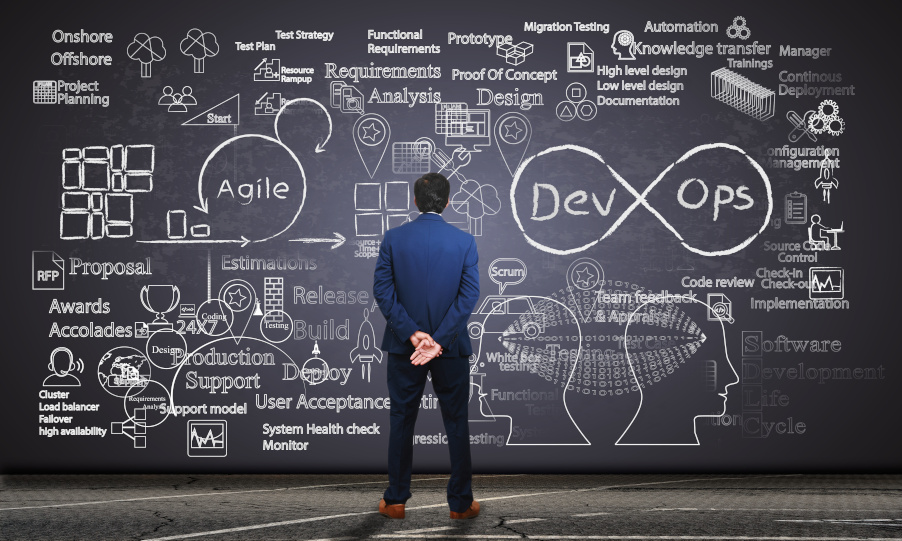Why AI matters for public administration: 4 compelling reasons!

AI, widely acknowledged as a powerful tool to boost efficiency and productivity, has made remarkable success, gaining traction across various sectors and activities.
1. AI, a catalyst for E-Government Development
- In Australia, the Business Registration Service, equivalent to Tunisia’s National Business Register, uses an AI-powered chatbot to guide users through the business registration process, providing real-time assistance and reducing the reliance on administrative staff.
- In New Zealand, the Companies Office uses predictive models to identify potentially fraudulent business registrations, ensuring a safer investment environment.
2. AI, a vital ally during crises
This example demonstrates the crucial role AI plays in enabling governments to respond swiftly and effectively in situations of crisis.
3. AI, a resource optimization tool
For instance, Singapore has used AI to automate processes such as birth registration and elderly care through its Life SG service, providing faster and more accurate services to its citizens.
Similarly, in India, the “Saagu Baagu” pilot project in agriculture used AI to assist 7,000 chili farmers, significantly improving productivity, quality, and, consequently, farmers’ incomes.
4. AI supporting strategic planning
Conclusion: AI will be a cornerstone of future E-Governments
In conclusion, AI offers transformative opportunities for public administration by enhancing efficiency, improving service delivery, and enabling better resource management. Governments around the world are increasingly adopting AI to streamline processes, optimize operations, and respond effectively to crises.
The technology also plays a critical role in strategic planning, providing valuable insights for data-driven decision-making. As public institutions embrace AI, they are better equipped to meet the evolving needs of citizens and deliver responsive, modern governance enabling them to achieve higher levels of development and competitiveness. Ultimately, AI will be a cornerstone of future E-Governments, fostering innovation and sustainable public services.
Content
How IT projects succeed: Opportunities and limits of agile software development

A lot has changed in the IT world: Companies are increasingly focusing on digital transformation and modernisation, but despite these efforts, many projects still fail. Studies show that 70% of digital transformation projects do not fully achieve their goals. There are many reasons for this: from unclear alignment and a lack of prioritisation to outdated technologies and inadequate risk management. This also applies in particular to the implementation of IT projects.
As think tank, we can look back on many years of experience in the consulting and implementation of IT projects. We have experienced the developments in agile software development at first hand and have successfully implemented them in numerous projects. But agility is not always the best approach. Let us shed light on how agile methods can revolutionise IT projects – and where they reach their limits.
How agile methods can support the success of IT projects
Better alignment through continuous communication
Clear target definition and rapid measurement of success
Effective risk management and prioritisation
Where agile methods reach their limits
High regulatory requirements
Agility can be problematic in highly regulated sectors such as finance or healthcare. There are often strict legal requirements that demand clear documentation obligations and clearly defined processes. A classic waterfall model has proven to be advantageous here, as it enables precise planning and long-term documentation that fulfils regulatory requirements.
Complex dependencies and legacy systems
Lack of experience with agile methods
Our proven approach: The right method for your project
- How high is the degree of uncertainty or change?
High uncertainty requires agile methods, while more stable projects can benefit from classic models. - What resources and technologies are available?
We rely on agile or hybrid approaches for modern technologies and agile teams, and on more traditional methods for legacy systems. - How high are the requirements for control and documentation?
In highly regulated projects, we favour classic project management, while less regulated projects benefit from agile methods.
Conclusion: Choosing the right method leads to sustainable success
As an experienced consultancy, at think tank we combine agility where flexibility is required with traditional approaches when stability and control are needed. This hybrid approach has proven to be particularly successful in many projects.
Let’s find the best way for your IT project together – and make it a success.
Content:
Process optimization in five steps

Definition, meaning and implementation
Digital transformation goals such as greater customer focus, shorter time-to-market or improving product quality require many measures, one of which is process optimisation and therefore an important part of any successful corporate strategy in order to remain competitive.
Why is it important to optimize processes?
But why is effective process optimisation so important? Especially in times of increasing competitive pressure, companies need to continuously review and optimise their processes. This is not only about saving time and costs, but also about taking customer requirements into account. Well thought-out process optimisation enables companies to concentrate on their core competencies and generate long-term success. The use of state-of-the-art technologies, such as the automation or digitalisation of work processes, can also increase employee motivation.
Basics of process optimization
Process optimisation is based on a comprehensive analysis of existing processes. This identifies weak points and potential for improvement, which can then be addressed in a targeted manner. However, process optimisation is not a one-off project – rather, it is a continuous process. Because even if an optimum result has been achieved, the processes must be regularly reviewed and adapted to new circumstances. In addition, clear goals should be defined. Only in this way can the company ensure long-term success through effective processes.
Goals of process optimization
The objectives of process optimisation are diverse and can vary depending on the company. First and foremost, it aims to improve the efficiency, quality and performance of business processes. Some of the most important goals are:
- Cost reduction: Costs can be reduced by identifying and eliminating waste, bottlenecks and inefficient activities in a process. Automation, reducing errors, shortening throughput times and optimising resource utilisation are the main factors here.
- Increasing productivity: Optimised process design enables employees to complete tasks more efficiently and therefore increase productivity. Simplifying processes and reducing waiting times are crucial here.
- Improving quality: Minimising errors, standardising work processes and implementing quality controls improves the quality of products or services.
- Increased customer satisfaction: Faster response to customer requirements, shorter delivery times and the provision of high-quality products and services lead to more satisfied customers.
- Flexibility and adaptability: Optimised process design supports adaptation to changing market conditions and improves competitiveness.
- Sustainability: Process optimisation helps to use resources more sparingly and reduce the environmental impact, e.g. by reducing the use of energy and materials.
Procedure for process optimization
To achieve maximum impact it is important to plan the approach to process optimisation in advance as well as to take into account the specific needs of the company, its customers and its employees when selecting methods and processes. Successful process optimisation requires a clear strategy and committed employees. All stakeholders should therefore be integrated into the change process from the outset in order to minimise resistance within the company.
Step 1: Analyse and document processes
The first measure is to analyse and document existing processes in connection with the entire IT landscape. Changes affect different areas of the company, so it is important to have a precise overview of the interrelationships. Relevant information such as time and resource requirements as well as potential weak points should be recorded.
Step 2: Identify potential for improvement
Weak points or bottlenecks can be identified on the basis of the documented processes. Customer requirements and employee concerns should be taken into account in order to better fulfil their needs. In this step, goals are also defined that are to be achieved through the process improvement, including KPI definition.
Step 3: Develop a strategy
After analysing processes and identifying potential for improvement, it is crucial to develop a strategy. This includes prioritising the processes to be optimised and defining KPIs at process and team level.
Step 4: Take measures for optimization
Specific optimisation measures can be developed on the basis of the analysis results. This includes deciding on the requirements for the IT architecture, the selection of tools and working methods.
Step 5: Monitor and continuously improve implementation
The measures implemented must be regularly reviewed and adjusted in order to achieve a sustainable effect. Key performance indicator systems show the success and adjustments must be made if necessary. Monitoring ensures that the optimised processes have the desired effect, e.g. in the form of cost savings or higher product quality. New market developments should be taken into account and team members must be empowered to make the best use of the new processes and tools.
Challenges and success factors in process optimisation
However, successful process optimisation can also pose challenges. One of the biggest hurdles is often the acceptance and commitment of employees, as changes to the workflow can cause uncertainty and resistance. Clear communication is an important success factor here. Goals should be communicated transparently in order to get everyone involved on the same page. A realistic timetable for implementation should also be set – after all, complex processes cannot be optimised overnight.
Trends and developments in process optimization
A clear trend in the area of process optimisation, particularly in the area of production processes, is the automation of processes, for example in the form of robotic process automation (RPA), in order to reduce manual tasks and achieve efficiency gains.
Digital transformation also remains an important topic. Companies are utilising technologies such as cloud computing, big data analytics and artificial intelligence to improve their processes and make better decisions. AI is becoming increasingly important here, just as it is in automation. This is because AI provides data analyses that can be used to identify inefficient processes. This enables companies to react to problems at an early stage and prevent potential bottlenecks, resulting in a smoother and more efficient process landscape overall.
In line with the trend towards digital transformation, agile methods continue to be used frequently and processes are being streamlined according to lean management principles. Customer journey mapping, which incorporates the customer perspective and thus helps companies to better understand and harmonise their processes, takes account of increased customer demands.
In order to meet the increased need for communication, the use of collaboration tools is increasing, as such frameworks enable a more efficient exchange of information between employees and teams, which helps to optimise processes.
Recommendations for future process optimization projects
However, there are a few key points to consider for the success of process optimisation projects:
- Involvement of all relevant stakeholders: To ensure the acceptance and commitment of employees, it is important to involve all stakeholders in the optimisation process at an early stage. This can be done through workshops or regular team meetings, for example.
- Use of agile methods: Agile approaches such as Scrum or Kanban can help to promote continuous improvement and achieve faster results.
- Use of modern technologies: The use of digital solutions such as workflow management systems or robotic process automation (RPA) enables efficient automation of workflows and helps to increase productivity.
- Set measurable goals: Clear objectives with measurable KPIs create a basis for reviewing the success of the optimisation process and making adjustments if necessary.
- Continuous monitoring & obtaining feedback: Regular monitoring and review of the optimised processes as well as obtaining feedback both internally and externally are decisive factors for sustainable success in the context of professional process optimisation.
Successful process optimization
It has become clear that there are a number of factors that need to be taken into account if process optimisation is to be successful. The basic prerequisite is precise knowledge of the process landscape in the company as well as a clear strategy and objectives for implementation, in which the customer and employees should take centre stage. It is therefore crucial that all stakeholders are involved in the process from the outset, as change can only succeed if everyone involved is convinced that the project makes sense.
Content:
Hire an external Scrum Master?

Why it is a good decision for your project
Have you trained your staff and introduced agile ways of working? As a next step, it may be wise to hire an external Scrum Master to get your project on track and further empower your staff until this role can be taken over by an internal employee. After all, an experienced Scrum Master supports you and your team in setting the right priorities, following the most effective work processes and ensuring the quality of the results.
What does a Scrum Master do?
A Scrum Master has a central role in the Scrum Team. Not only is he responsible for supporting the team in implementing Scrum processes, he is also responsible for ensuring that the team is working effectively and efficiently and that obstacles that may hinder the team’s progress are removed. Therefore, it is important that a good Scrum Master is an experienced and motivating team leader who is able to inspire and motivate the team to achieve the best result.
By hiring an external Scrum Master, you can ensure that you have an experienced and skilled leader who can lead your project to success. A Scrum Master can also help you improve your Scrum processes and motivate your team to achieve better results. With a Scrum Master on board, you can be sure that your project is in good hands and that you will achieve the best possible results.
Why should you hire an external Scrum Master?
When you are planning a project, it is often difficult to keep track of all aspects. An external Scrum Master can be a great support because he already has practical experience from different companies and projects. He or she can therefore be deployed immediately without having to be trained extensively. This way, you can ensure that communication between the team members runs smoothly from the beginning and that conflicts are solved from the start before they become a problem.
In addition, you are not tied to a specific timeframe as you would be with a permanent employee, but can decide for yourself how long you need the external support in order to possibly train an existing employee to the point where he or she can take over the role. This is not only easy on the budget, you also receive internal training in agile working through the knowledge transfer that takes place between the Scrum Master and the team members.
How do I choose the right Scrum Master?
Of course it is important that you find the right person for your team. A good Scrum Master should not only have a sound knowledge of Scrum, but also strong leadership skills and experience in working with teams. It is therefore advisable to take time to interview potential candidates and assess their skills and experience. Make sure that the Scrum Master can motivate and inspire your team to achieve the best possible result.
Also, make sure that the Scrum Master can work well with your team and your company. Good communication and a good understanding of the company culture are essential to ensure that the project is completed successfully.
What are the additional benefits of this solution?
It is often difficult to find the right person for the role of Scrum Master at the start of a project and many choose to hire an external Scrum Master: but why choose this option? Quite simply, an external Scrum Master brings a breath of fresh air to the project and can contribute to its successful completion with new ideas and perspectives.
In addition, an external Scrum Master often has extensive experience from various projects and can thus bring valuable tips and tricks. He or she can also act independently of internal structures and hierarchies and thus ensure more efficiency in the project. All in all, hiring an external Scrum Master offers many advantages and can be a wise decision for any project.
Conclusion
What is the bottom line of it all? If you have a project that you want to complete successfully, hiring an external Scrum Master is a wise decision. He has the knowledge and experience to lead your team and make sure everything runs smoothly. He can also help solve problems and make sure the project stays within budget and on schedule. This way, you can be sure that you will get the best out of your team and that your project will be completed successfully. So, what are you waiting for? Hire an external Scrum Master and make your project a success!
Content:
Creating added value for companies, employees and customers

Think big: Why a vision is so important
Buzz words like digital or agile transformation are buzzing around in many heads. But why should companies deal with this and what does a shared vision have to do with this topic? The objective of both is to create added value for the company, the employees and the customers and to remain competitive in a world full of disruptions.
Advantages of a corporate vision
First, a brief clarification of terms: The vision describes a desirable state in the future to which employees can orient themselves. This so-called North Star shows where to a company would like to develop. At the same time, it serves as motivation and as a basis for decision-making for the entire organisation.
In its external presentation, the company distinguishes itself from its competitors through its vision of the future and can present how and for what it stands and works. However, it is crucial that the vision inspires and engages everyone. But how is it possible to develop such a rousing vision of the future for one’s own company or to sharpen an existing one?
Approach and methods
At the beginning, as with every process, there is an analysis of the current situation. In targeted interviews, employees at all levels have the opportunity to express their views. This approach offers the advantage that large parts of the staff are integrated and a more comprehensive picture of the company emerges.
In cross-hierarchical and -functional workshops, e.g. using the Walt Disney method, the six hats or the future workshop, the new image of the future can be developed together. The conscious use of creative methods opens up the space for new possibilities to leave the usual paths.
Because as Einstein already said:
“The definition of insanity is: doing the same thing over and over again and expecting different results. “
Vision and agile transformation
But what does a vision have to do with agile transformation? By comparing the current state with the vision, it becomes clear what the company can already achieve in terms of existing working models, processes and culture and where the gaps are.
It thus forms the basis for initial ideas to plan the necessary measures for the agile transformation. In addition, a common goal can help to ensure that staff and management accept and want to help shape the changes that every agile transformation brings with it.
Objective agile transformation
One of the primary goals of agile transformation is to make a company more resilient and competitive. This is achieved by simplifying processes and organisational structures in agile organisations, allowing the space for rapid decision-making within the framework of self-organisation.
This also requires a new form of leadership that promotes and demands a high degree of teamwork and self-organisation. What is needed here is not only situational leadership, but the strong leadership form of leadership in which the supervisor shadows, supports and coaches the team. This in turn leads to an increase in the level of innovation and employee engagement as well as responsiveness to changes in the market or in customer needs.
Of course, this contributes greatly to customer satisfaction and thus secures the future of the company. However, it is clear that such a far-reaching change as the agile transformation must be well planned and accompanied in order to empower both management and employees to shape it and drive it forward.
Image of the future as a positive driver
So a clear vision brings many benefits, both in general and in terms of agile transformation. The biggest one, however, is that the focus on a common goal that everyone wants to achieve together bundles a lot of positive energy and decisions are supported by everyone. In this way, every company takes an important step towards a future that enables long-term success.
Content:
Agile transformation in the banking environment

Challenges and solutions
Change is difficult for most people. However, the hurdles are often particularly high in very traditional companies and in the banking environment, even though the knowledge that a change towards digitalisation and agility is inevitable has become established in this sector. However, there are a number of things to consider when introducing agile working.
Stakeholder analysis and hands-on training
The most important thing is to identify and meet all stakeholders in a first step, for example in the form of a stakeholder analysis. In this way, they can be convinced of the necessity and feasibility despite the many regulations that exist in a banking environment. Because the agile transformation can only succeed if there is a willingness to change at all levels. This is especially true for the management level, where, as in many industries, a classic understanding of leadership still prevails.
For external consultants who accompany this change, it is therefore particularly important to create a basis of trust. This can be achieved through successful communication on the part of the consultants as well as practical training, in which not only the know-how but also the practical approach is conveyed and its advantages made clear. Intensive training in advance also results in a better understanding of agile work from the outset. Ultimately, however, it is the constantly improving results that provide the best arguments.
Coaching and team building support agile transformation
An important tool for supporting the agile transformation, especially in banks, is coaching, in which old thought patterns can be softened in order to increase acceptance for innovations. This is particularly important because prior knowledge on the topic of agility can vary greatly and individual employees therefore have different attitudes to it. Through group or individual coaching, consultants can also bring employees to a common level.
Since new teams are often created during agile working, team building measures are essential from the beginning to strengthen trust among each other on the one hand and to work together on the new working model on the other. Because agile working works differently in every company and should and must be shaped by the employees. This also means that solutions are developed by consultants together with the employees and the management.
Support from external experts in new roles
If management is involved in the process and also in the training sessions from the very beginning, the risk of a blocking attitude from this direction can be successfully prevented or at least minimised. Conflicts within the team or with the management can be recognised more quickly and can also be solved better.
In addition to good preparation of the team and management, it makes sense to bring in experience in the form of external support, for example as a Scrum Master, in order to introduce the necessary processes and empower the employees to shape the change themselves. Because every change needs time and support. What this looks like varies from case to case, of course.
In conclusion, it can be said that agile transformation can make a lot of sense in the banking environment, especially in IT applications. The prerequisite for this is that the special circumstances in the banking environment are taken into account and that the introduction of new working models and processes is prepared and accompanied accordingly.
Content:
Kanban vs Scrum? Which method leads to success?

Advantages and disadvantages of agile working methods
Those who decide to work agilely are spoilt for choice when it comes to methods. Kanban, Scrum or Lean Management are just a few of the keywords that are on everyone’s lips. Often, it is Scrum with its precisely timed sprints and user stories that those in charge choose. Whether this decision was the right one sometimes only becomes clear after a long process of trial and error. How can such a mistake be avoided?
Decision criteria for agile development methods
There is no generally valid answer to this, but some criteria can help to make a reorientation in the middle of a work process. The best way to explain this is to use a negative example in the case of a choice between Kanban and Scrum. Because it is also true in agile working that mistakes are the best teachers.
In our case, the client was faced with the challenge of organising a team that worked at different locations and whose participants did not all speak the same language. In other words, the best conditions for agile working. The task was to further develop a product that was in operation. Therefore, the choice of agile method fell on Scrum. With its clearly structured blocks, sprints and firmly outlined requirements described in user stories, this method is very popular in product development.
Adapting the agile approach
In our case, however, exactly what is otherwise an advantage became problematic: the requirements, which were precisely tailored to the team, did fit the mandate to further develop the product. In addition, however, the team had to take over the ongoing operation and support. As a result, critical defects were repeatedly added to the already existing tasks, the processing of which could not wait until the next sprint. The workload of the individual team members increased, as they felt obligated to their commitment to the user stories.
An adjustment of the method became necessary. After careful consideration, the decision was made to implement the task with Kanban. From then on, both the further development and the ongoing operation ran without further problems. But why was the Kanban method better suited than the Scrum method in this case?
Difference Scrum Kanban
It makes sense to look at the fundamental differences in the methodology of the two approaches. On the one hand we have Scrum. Here, precisely specified scopes of work are defined for a certain period of time and the progress is communicated in the daily routine. Here, it is not planned that the requirements change in the course of a sprint or that more are added, which works wonderfully well with a precisely outlined task without “disruptive factors”.
The Kanban method, on the other hand, is primarily about establishing a continuous flow of work. For this purpose, the individual work processes from the idea to the completion of the task are made visible in various so-called status columns. The starting point is usually a collection of prioritised pending issues, which are drawn up by the individual team members themselves. The ingenious thing about this is that only a certain number of tasks may be listed under the individual headings of the tables, i.e. it is not possible to start any number of new tasks before others have been completed.
Advantages of the Kanban method
This leads to tasks being completed, but unlike Scrum, it allows new requirements/ideas to be fed into the process. Of course, prioritisation of tasks and monitoring is necessary so that no “task corpses” are left on the way to completion. The product owner is responsible for monitoring the continuous process to ensure that no tasks are left undone.
Another difference is the focus of the dailies. While Scrum focuses on the team members, Kanban is more about organising the tasks and finding solutions to problems that arise.
More flexibility and faster work flow through Kanban
In our case, it became clear that Kanban had to be the method of choice because it fulfilled two requirements that were necessary for the successful implementation in the client’s sense: it was possible to feed in newly arising problems and, by focusing on the workflow, it guaranteed that both the activities that could be planned in the longer term and those that were newly added were completed.
What we have learned from this is that it is important from the beginning to examine exactly which factors play a role in the completion of a task in order to find the appropriate method. In keeping with the spirit of agility and the fault tolerance implicit in it, the courage is required to revise and reconsider a decision that has already been made if it becomes clear after the application has been launched that one has made a mistake in the choice of method.
Content:
Resilient in times of crisis: Adaptive or rather agile?

How companies can position themselves for the future
In a world characterised by crises and rapid changes, the concept of resilience is also gaining more and more importance for companies. But what does resilience mean in this context and how can the concept, which originates in psychology, be transferred to it? If you read up on the subject on the internet, two terms quickly come to mind: Adaptability and innovative learning culture.
Taking external factors into account
From these terms, it is not far to the buzzword agility. For a long time, agile working was seen as the magic bullet for making a company so crisis-proof that it could react adequately to the rapid changes so typical of our times and thus remain fit for the future. In the meantime, this way of working has lost its nimbus of being a universal remedy. What remains, however, is the need to adapt quickly to new circumstances in order to be resilient. But how can this best be achieved? This is where the topic of adaptive organisation comes into play. A one-sided perspective from which an agile way of working is introduced usually does not lead to the desired improvement. Instead, in the sense of systemic thinking, all systems, internal complexity as well as external circumstances such as competitors, market changes, wars must be considered and taken into account.
Resilient through a change of perspective
The decisive factor is therefore a change of perspective to the meta-level, i.e. a view from the outside of the company and its influencing factors. From this changed perspective, other possibilities arise and potential for improvement becomes visible. However, it is a fallacy that this potential can only ever be exploited by introducing an agile way of working. It is important to find the right means for your own organisation. Because just because a method such as design thinking was the perfect solution approach for a topic, this does not mean that this approach will be the means of choice the next time. If we return to the initial question, it can be said that agile and adaptive are not mutually exclusive; rather, agility is a building block for creating an adaptive organisation.
However, the change from a classic or agile to an adaptive organisation can only succeed if it takes into account not only the external but also the human factors such as corporate culture, communication and the employees.
Balance between structure and flexibility
It is important to develop a balance between structures and flexibility. This is the only way to create a protected framework in which new creative spaces can open up and solutions can be found. In this way, a company can change sustainably and, in the spirit of resilience, protect itself against external influences. This process is never complete. Only when an organisation continues to develop is it protected in the long term against the disruptive influences of the outside world.
The conclusion to be drawn from the question of agile or adaptive is therefore that agility is usually part of an adaptive organisation, but its methods alone are not always sufficient; companies must always keep the big picture in mind when making adjustments and changes.
Content:
Agile transformation begins in the mind

The six biggest prejudices about agility
The topic of agility and agile transformation has arrived at most companies as an alternative to traditional work processes. But to this day, some misconceptions stubbornly persist among both proponents and critics of agile working.
Agility is chaotic
Until today, many decision-makers in companies believe that working agile means that there are no fixed responsibilities. The result is organisational chaos that no one can keep track of. In reality, however, there are requirements that have to be met even in agile working. What is not specified is how these are to be implemented. The responsibility for this lies with the team. The advantage is that there is no basis for assigning blame and the focus is on solving the problem.
If I use agile methods, I am agile
Another misconception is that it is already enough to introduce agile methods such as Scrum or a Kanban Board in order to benefit from the advantages of agile working. But there is much more to agility. A prerequisite for the successful implementation of the agile transformation is that it is incorporated into the company’s goals. Only in this way a corresponding agile mindset can develop among the employees and the company management.
Agility only works for software development and start-ups
If you start from this premise, it is also quickly clear that agile project management works in many areas. After all, agility is a matter of mentality and means above all that all employees are willing to take responsibility and to design and adapt their processes themselves according to the tasks to be solved require. This enables companies to react better to the ever faster changing circumstances.
Agile working is the answer to everything
Conversely, this does not mean that agile working makes sense for every company or every task. If the existing structures and processes work well, there is no reason per se to adapt them, as change causes unrest and must be accompanied. A regular review of the existing organisation always makes sense, because as the Corona pandemic showed, circumstances can change quickly.
Agile transformation is done in three months
The experience with the pandemic and the necessary adjustments associated with it have shown that change takes time. The same is even more true when introducing the agile way of working. Not only do the processes have to be adapted, but the entire corporate culture has to be changed. The transformation towards agile working is an ongoing process in which the narrative that exists in every company has to be reworked and developed.
Agility no longer needs leadership
The last misconception closes the circle. Because of course agile organisations need leadership. However, the understanding of a leader is different. He or she is part of the team and becomes a coach, creating the framework conditions so that the team members can carry out their work as undisturbed as possible. Important here is communication at eye level and a pronounced tolerance for mistakes.
If one takes a closer look at these prejudices, several conclusions can be drawn: Firstly: every company should check for itself whether and to what extent agile working makes sense for its own goals. Secondly, anyone who decides in favour of agile transformation should be aware that, in addition to the external structures, the attitude of the employees must also change. Because agility begins in the mind. That’s why the agile transformation needs time and often support from outside.
Content:
Why is digitalisation so slow in Germany?

Background, causes and solutions
Corona has provided a digitalisation boost in some areas, but overall Germany continues to lag behind in digitalisation. In a study by the Berlin-based European Center for Digital Competitiveness (ECDC), Germany only ranked 17th among the digital upstarts of the G20 countries. Why is Germany having such a hard time with digitalisation?
What does digitalisation mean: a clarification of terms
First of all, a clarification of terms: what exactly is meant by digitalisation? Digitalisation affects everyone in society, but especially the economy. Here we speak of digital transformation or digital change. It refers to changes in processes, forms of work, customer interactions, products, services and complete business models. For example, during the Corona crisis, communication was moved to online platforms or companies are developing apps to offer their services there as well.
Front-runner and tail-runner in digitalisation
Looking at these examples, it is not surprising that there are large fluctuations in the state of digitalisation in Germany, both among the sectors and among the company sizes. Overall, however, an upward trend can be seen in most sectors and company types. The frontrunners in terms of sectors are the information and communications industry, followed by the automotive and mechanical engineering industries and business-related service providers. In terms of company size, companies with more than 250 employees are ahead with a digitisation index of 205.2. The value for medium-sized companies declined (125.4 to 119.4), and companies with 1 – 49 employees were able to increase their degree of digitalisation, but still only have a value of 93.9. The digitalisation index is based on 50 indicators such as the digitalisation of processes or human capital.
Ziele der digitalen Transformation
Klar ist jedoch, dass die Notwendigkeit des digitalen Wandels in den Köpfen angekommen ist und dass Unternehmen begonnen haben, an ihrer Transformation zu arbeiten. So verfügen inzwischen insgesamt 83% der Unternehmen über eine Digitalisierungsstrategie. Allerdings gibt ein Drittel der Befragten immer noch an, keine zentrale Strategie für die Digitalisierung zu haben, was sich langfristig auf die Erfolgschancen der Unternehmen auswirken kann. Hauptmotive für die Digitalisierung sind laut einer Studie der DIHK unter etwa 3500 Unternehmen vor allem die strategische Unternehmensentwicklung und Effizienzsteigerungen durch Kostensenkung (jeweils 57 Prozent). Auf Platz zwei liegt die Erhöhung der Kundenbindung (53 Prozent), gefolgt von der Flexibilisierung der Unternehmensprozesse bzw. Workflows (52 Prozent).
Goals of the digital transformation
What is clear, however, is that the need for digital transformation has entered people’s minds and that companies have begun to work on their transformation. Thus, a total of 83% of companies now have a digitalisation strategy. However, one third of respondents still say they do not have a central strategy for digitalisation, which can have an impact on companies’ chances of success in the long term. The main motives for digitalisation, according to a study of around 3,500 companies by the DIHK, are above all strategic corporate development and efficiency increases through cost reduction (57 percent each). In second place is increasing customer loyalty (53 percent), followed by making company processes or workflows more flexible (52 percent).
Main reasons for problems with digitalisation
There are many reasons why digitalisation projects fail or are not tackled at all. According to a survey by the DIHK, small and medium-sized enterprises in particular shy away from the high investment costs. In the first place, however, is the complexity that companies see in the implementation inot existing systems and processes. Of course, human capital also plays a role here. As in the case of the digitalisation index, it can be seen here again that the know-how for the conversion of processes or business models is lacking in the companies and must be purchased or created through further training measures. A study by the d.velop blog looks at other reasons for the failure of many a digitalisation project. The respondents see a major issue in the fact that digitalisation affects every company differently and a clear definition of requirements across all departments and areas of the company is difficult. A good third also stated that they have methodological implementation problems because they are not familiar with the agile way of working, which is important for change, and therefore do not succeed in the transition.
Possible solutions: Use of consultants and nearshoring
As is so often the case, it is difficult to change and make a transition on your own. Especially in the area of digitalisation and agility, it therefore makes sense to hire external consultants and thus buy in the missing know-how. With expert eyes and the necessary distance, they can achieve what internal employees can almost only fail at: a precise analysis of the current situation with a roadmap on how companies can use digitalisation for themselves and gradually adapt their processes. In training and coaching sessions, employees can learn new agile ways of working and adjust their mindset, which is necessary for this new form of collaboration. In order to avoid a cost explosion when adapting processes that require a new technological solution, outsourcing IT projects to nearshoring partners is a good alternative, as communication is guaranteed here due to a common working language and similar mentality . We offer a full service solution in this area. Do you have any questions? Contact us!